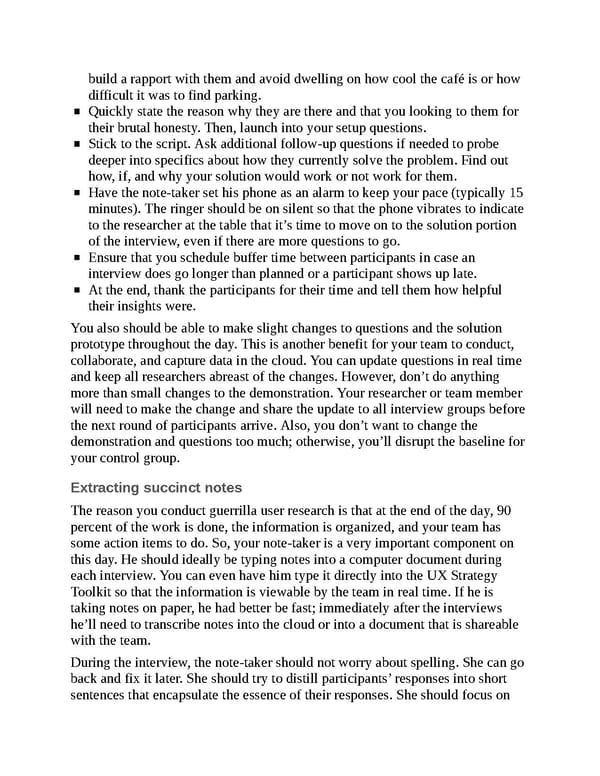build a rapport with them and avoid dwelling on how cool the café is or how difficult it was to find parking. Quickly state the reason why they are there and that you looking to them for their brutal honesty. Then, launch into your setup questions. Stick to the script. Ask additional follow-up questions if needed to probe deeper into specifics about how they currently solve the problem. Find out how, if, and why your solution would work or not work for them. Have the note-taker set his phone as an alarm to keep your pace (typically 15 minutes). The ringer should be on silent so that the phone vibrates to indicate to the researcher at the table that it’s time to move on to the solution portion of the interview, even if there are more questions to go. Ensure that you schedule buffer time between participants in case an interview does go longer than planned or a participant shows up late. At the end, thank the participants for their time and tell them how helpful their insights were. You also should be able to make slight changes to questions and the solution prototype throughout the day. This is another benefit for your team to conduct, collaborate, and capture data in the cloud. You can update questions in real time and keep all researchers abreast of the changes. However, don’t do anything more than small changes to the demonstration. Your researcher or team member will need to make the change and share the update to all interview groups before the next round of participants arrive. Also, you don’t want to change the demonstration and questions too much; otherwise, you’ll disrupt the baseline for your control group. Extracting succinct notes The reason you conduct guerrilla user research is that at the end of the day, 90 percent of the work is done, the information is organized, and your team has some action items to do. So, your note-taker is a very important component on this day. He should ideally be typing notes into a computer document during each interview. You can even have him type it directly into the UX Strategy Toolkit so that the information is viewable by the team in real time. If he is taking notes on paper, he had better be fast; immediately after the interviews he’ll need to transcribe notes into the cloud or into a document that is shareable with the team. During the interview, the note-taker should not worry about spelling. She can go back and fix it later. She should try to distill participants’ responses into short sentences that encapsulate the essence of their responses. She should focus on
 UX Strategy: How to Devise Innovative Digital Products that People Want Page 236 Page 238
UX Strategy: How to Devise Innovative Digital Products that People Want Page 236 Page 238